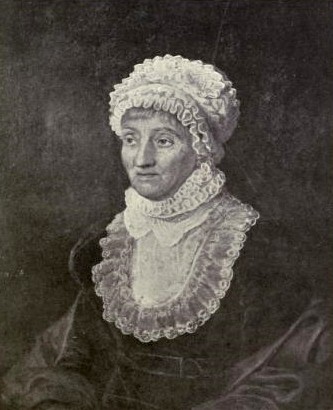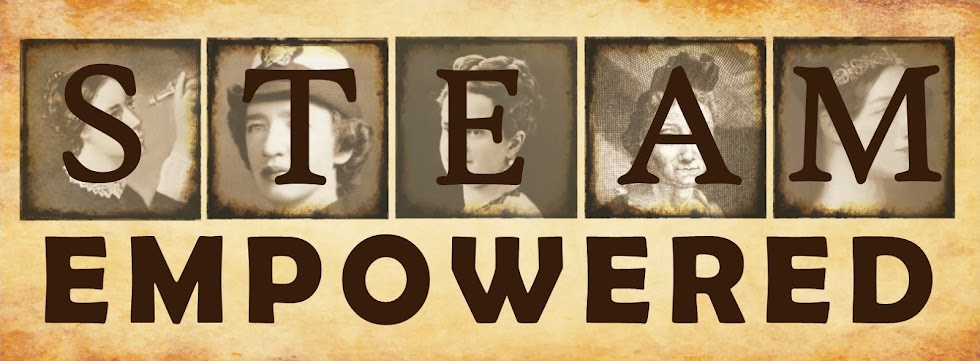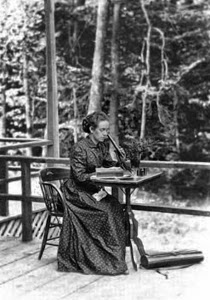Written by Jill M. Staake
March 16, 1750 - January 9, 1848
Hanover, Prussia (Germany) and Slough, England
 |
| Caroline Herschel 1829, by M. F. Tielemanm |
S.T.E.A.M. Powers
- Astronomer
- Discovered eight comets
- Assisted her brother William Herschel, who discovered the planet Uranus, as the first paid female astronomer
- First female member of the Royal Astronomical Society (with Mary Somerville)
- Received the Gold Medal from the Royal Astronomical Society, and the Gold Medal for Science from the King of Prussia
Her Story...
When astronomer Caroline Herschel died at the age of 97 in 1848, her gravestone was engraved with
the epitaph she herself had written:
...The eyes of her who passed to glory, while below turned to the starry heavens; her own discoveries of the comets and her share in the immortal labours of her Brother, William Herschel, bear witness of this to later ages...
But this remarkable woman left more behind than a beautifully composed elegy; she had the discovery of eight comets to her name, a Gold Medal for Science from the King of Prussia, and the honor of being one of the first two female members of the Royal Astronomical Society. She was well-recognized by her colleagues in the natural sciences as a fine astronomer and scientist, and corresponded regularly with contemporaries such as Alexander von Humboldt and Joseph Banks. Her steadfast assistance to her astronomer brother William Herschel led to a steady paycheck from the King of England, and there is even
a crater on the moon named for her. Like so many great men and women, though, she started from very humble beginnings.
 |
| Caroline's signature (her given name in German was Carolina) from her music books. via Yale Library |
Per Aspera Ad Astera
Born in Hanover in 1750 as the fifth of six children in a musical family, Caroline's childhood was not very promising. A bout with typhus at the age of ten left her with a scarred face and stunted growth; her biographers note she was less than five feet tall. Her father attempted to provide her with some education, but her mother felt it was unnecessary for her to learn much beyond basic reading and writing. After the death of her father, Caroline's mother reluctantly agreed to allow her to follow in the musical footsteps of her father and brothers, who were all well-known and successful musicians. Caroline joined her brother William, who had moved to Bath in England, and began to study singing.
 |
| An advertisement for a concert where Caroline Herschel performed |
This was, without a doubt, the turning point of her life. She became a successful concert singer, but soon discovered that her brother was much more devoted to his hobby as an astronomer than his job as a music teacher. Caroline, being devoted mainly to William, joined him as his assistant, and two amazing astronomical careers were launched.
"I Am Hooked!"
Being the assistant to an astronomer was a less than glamorous job. In the beginning, Caroline mainly served as a note-taker and secretary for William as he studied the sky night after night, sitting faithfully by his side in all weathers.
He progressed from early smaller telescopes to much larger ones, building a 20-foot telescope that required the astronomer to sit on a high platform to make observations while assistants below made adjustments and took notes. By 1782, William was made King's Astronomer to King George III, and by 1787, Caroline had been granted her own salary of 50 pounds per year to serve as William's assistant.
Caroline was invaluable to her brother, remaining at William's side through cold nights and illnesses. Her dedication is best expressed by the happenings one cold night in December 1783.
My brother, at the front of the telescope, directed me to make some alteration in the lateral motion, which was done by machinery, on which the point of support of the tube and mirror rested. At each end of the machine or trough was an iron hook, such as butchers use for hanging their joints upon, and having to run in the dark on ground covered a foot deep with melting snow, I fell on one of these hooks, which entered my right leg above the knee. My brother's call, "Make haste!" I could only answer by a pitiful cry, "I am hooked!"
William and the workmen immediately came to her rescue, but as Caroline noted, "they could not lift me without leaving nearly two ounces of my flesh behind." Caroline hobbled around for weeks while it healed, but her main concern seems to have been the effect on her brother's work: "I had, however, the comfort to know that my brother was no loser through this accident, for the remainder of the night was cloudy."
 |
| William Herschel's 20-foot scope. Caroline would have remained on the ground to take notes and make adjustments. |
The Comet Sweeper
By now, Caroline was hooked in more than one way on astronomy. Her brother had given her own seven-foot Newtonian telescope earlier in 1783, and when she wasn't needed by him for other astronomical tasks, she spent hours each night "sweeping" the sky to look for comets. Her first concern was still William and his needs: "I began to use the new Newtonian small sweeper... but it could hardly be expected that I should meet with any comets in the part of the heavens where I swept, for I generally chose my situation by the side of my brother's instrument, that I might be ready to run to the clock or write down memorandums."
In 1786, though, her own work suddenly vaulted her into the spotlight. It began with a simple note in her diary on August 1: "This evening I saw an object which I believe will prove to-morrow night to be a comet." She waited anxiously through a day of poor weather on the 2nd, but by 1:00 in the morning, the skies were clear enough for her to be able to say, "The object of last night
is a comet." Her use of italics is all that betrays what must have been almost unbearable suspense and excitement.
William was out of town at the time, but Caroline was well used to corresponding with other scientists of the age. She sent several letters asking for others to help confirm her sighting, which they quickly did. Friends and colleagues delighted in the discovery, perhaps especially so because it was made by Caroline herself, rather than her brother. Fellow astronomer Alex Aubert wrote: "I am more pleased than you can well conceive that
you have made it, and I think I see your wonderfully clever and wonderfully amiable brother, upon the news of it, shed a tear of joy. You have immortalized your name."
In the years ahead, Caroline would discover seven more comets, bringing her total to eight. She also was the first to document several important nebulae and star clusters. Contemporaries like Messier documented dozens of new astronomical objects in their lifetimes, but much of Caroline's own time was taken up by work for her brother. The time she had to focus on her own work was limited, but she accomplished much and was well-respected by her peers. Sir Joseph Banks, head of the Royal Society, wrote to her on the discovery of her third comet: "I am always happy to hear from you, but never more so than when you give me an opportunity of expressing my obligations to you for advancing the science you cultivate with so much success."
Astronomical Merit
In 1788, William Herschel married, and Caroline left him to live on her own for the first time. She continued to work with him closely, but had more time to focus on her own discoveries. William died in 1822, and Caroline made a somewhat startling choice - she left England, which had been her home for decades, and returned to Hanover, the city of her birth. She maintained a close relationship with her nephew, William's son John, who was an admirable astronomer and scientist in his own right, and continued to be revered in the scientific community.
 |
Despite the scientific community's great respect for
her, Caroline's interest were still mocked by some,
as in this cartoon drawn in 1785.
via The Herschel Museum of Astronomy |
Caroline spent years working on a catalog of 2,500 nebulae William had charted in his lifetime, and in 1828, the Royal Astronomical Society awarded her the Gold Medal for this work. It was the first time a woman had been so honored - and it wouldn't be until 1996 that another woman (
Vera Rubin) received the honor again. In 1835, the Royal Astronomical Society went one step further, naming her one of their first female members (along with
Mary Somerville), noting: "that while the tests of astronomical merit should in no case be applied to the works of a woman less severely than to those of a man, the sex of the former should no longer be an obstacle to her receiving any acknowledgment which might be held due to the latter." In 1838, the Royal Irish Academy also elected her as an honorary member.
In 1846, her homeland also honored her. At the age of 96, she received the Gold Medal for Science from the King of Prussia. By this time, she had grown somewhat feeble, and the end of her life was near. She continued in good humor, though, as is evidenced by a quote from a letter written by a friend to her nephew: "[She] did not quite like old age with its weaknesses and infirmities, but...she too sometimes laughed at the world, [and] liked her meals." At age 97, she died peacefully at home, and her funeral was held in the same church where she had been christened nearly a century earlier. She was buried, at her request, with her father's almanac and a lock of her brother William's hair.
Riding The Polished Lenses
Caroline Herschel's name is sadly little known now outside the astronomical community, and sometimes even within. (An episode of the TV show Cosmos, which aired in 2014, covered the lives and accomplishments of William and John Herschel without even mentioning her name once.) But she is certainly not forgotten entirely. One of the comets she discovered bears her name (
35P/Herschel-Rigollet), and she even has
a crater on the moon named for her.
The poet Adrienne Rich wrote her poem
Planetarium with Caroline in mind (
See the full text here.). Her words paint the portrait of a hard-working woman, one with her feet firmly on the cold and snowy ground, but with a mind that soared among the stars - a legacy that Caroline surely deserves.
...a woman ‘in the snow
among the Clocks and instruments
or measuring the ground with poles’
...
she whom the moon ruled
like us
levitating into the night sky
riding the polished lenses...
Learn More about Caroline Herschel
Autobiography:
Other Books:
Online:
.jpg)

















.png)














.jpg)







.jpg)





